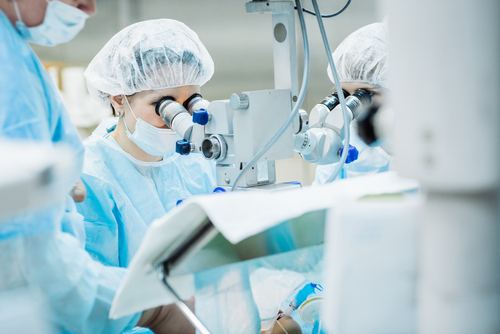
Posted by: Missouri Eye Institute in Blog on June 5, 2022

Cataract surgery is one of the most safe and most successful eye procedures and is performed to restore clear vision affected by cataracts. Recently, advances in technology have allowed surgeons to remove cataracts with lasers.
Unlike traditional cataract surgery, laser technology does not use blades. Instead, it utilizes advanced lasers, making it more precise and leading to a faster recovery.
Keep reading to learn more about what it is like to have laser cataract surgery!
If cataracts have affected your vision and visual aids no longer help, it’s best to see your eye doctor for help. During your visit, your doctor will assess the progression of your symptoms and suggest cataract surgery if necessary.
Prior to your laser cataract procedure, your eye doctor will take detailed measurements of your eye. These measurements will aid the surgeon in planning and customizing the surgery to align with the unique shape and size of your eye.
You will also need to select an artificial intraocular lens, also known as an IOL, that will replace your natural lens. Your eye doctor will help you choose an IOL that best matches your vision needs and lifestyle.
You will also be given detailed pre-surgery instructions. These may include applying drops beginning the day prior to surgery and for about three to four weeks post-op.
After you are given eye drops to numb the surface of your eyes, your cataract surgeon will place an imaging device over your eye to map its surface and collect information about your lens. These details will be sent to a computer that programs the laser for the exact depth, size, and location of the incision.
Once the femtosecond laser is programmed, your surgeon will use it to make an opening in the cornea, which is the transparent, dome-shaped layer that covers the front part of the eye. This incision enables the surgeon to reach the natural lens with a cataract.
Next, energy from another laser is used to gently soften and break the cataract into small pieces. The fragments are then carefully removed from your eye using suction.
After removing the natural lens, your cataract surgeon will place an artificial lens in your eye. Once your IOL is set correctly, the surgery is done.
The incision is tiny enough that it does not need sutures. It will be left to heal on its own.
Your cataract surgeon will place a protective shield over your eyes. Then, you will remain in the recovery room for about thirty minutes to one hour before being discharged.
You will also be given a pair of sunglasses to wear outside. Since you won’t be able to drive yourself, make prior arrangements for someone else to take you home.
Remember to follow all the doctor’s care instructions, including attending all your post-op appointments and applying prescribed drops for a smooth recovery.
After cataract surgery, you should rest as much as possible. It’s also essential to protect your eye from water as it heals.
Don’t get behind the wheel until your doctor gives you the green light to drive again. Recovery is often quick, however, the time required for full recovery will vary from person to person.
That said, most people can see clearly within twenty-four hours of their procedure and resume normal activities within a few days.
You do not have to live with poor eyesight due to cataracts. Laser-assisted cataract surgery at VisionPoint Eye Center is a quick, safe option to eliminate cataracts and restore clear, crisp vision.
Are you interested in knowing more about what having laser cataract surgery is like? Schedule your cataract screening at VisionPoint Eye Center in Champaign, IL, today.
Springfield
1531 E Bradford Parkway Ste 100
Springfield, MO 65804
Branson
1000 James F. Epps Rd Ste 2
Branson, MO 65616
Joplin
4500 E 32nd St
Joplin, MO 64804